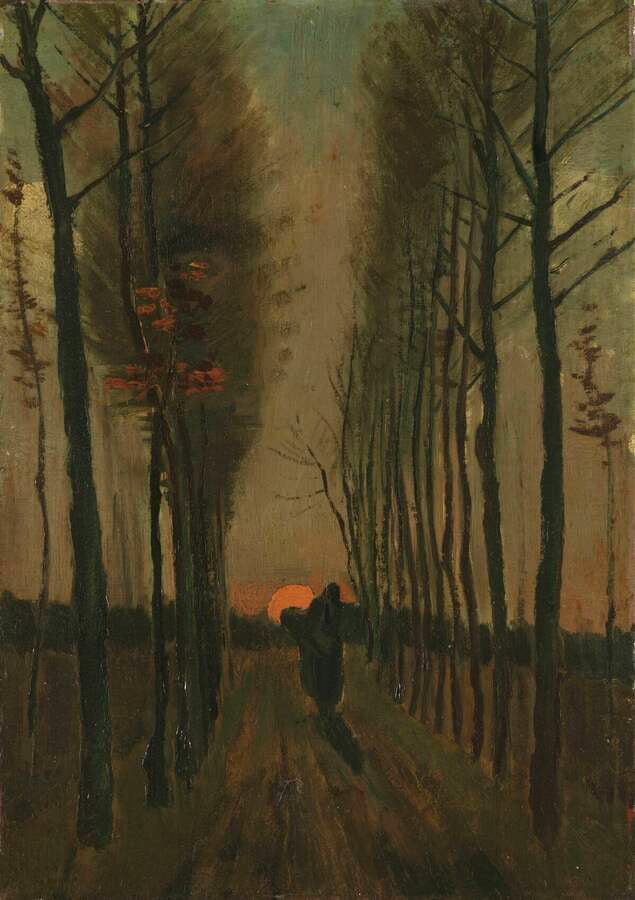
Being able to pinpoint a precise location of an area depicted in an artwork usually isn’t an exact science. However, Donald Olson, an astrophysicist and forensic astronomer at the State University System Regent, has used his scientific training to determine where Vincent van Gogh’s iconic 1884 work, Lane of Poplars at Sunset (now held by the Kröller-Müller Museum in the Netherlands), was in fact painted.
Olson previously used a similar astronomical methodology to date three other Van Gogh paintings including Moonrise (Wheat Stacks), Road With Cypress and Star, and White House at Night. For his most recent attempt, he enlisted the help of Louis Verbraak and Ferry Zijp, members of the Eindhoven Weather and Astronomy Club in the Netherlands, and determined that the lane of poplar trees depicted in work were created shortly before sunset on November 13 or 14 in 1884, along a 365-meter stretch of road known as Weverstraat in the Dutch town of Nuenen.
Vincent van Gogh, White House at Night (1890). Photo: VCG Wilson / Corbis via Getty Images.
When concluding the precise time and location, Olson first had to find the specific painting’s specific site. “If we could identify the lane on 19th-century maps, then we’d be able to establish the compass direction of the road appearing in the artworks,” he explained in a press release. “Next, we could use astronomical calculations to determine the date when the disk of the setting sun aligned as Van Gogh portrayed it.”
The next phase of his research also involved some art-historical sleuthing. He referred to the 1928 catalogue raisonné on the artist compiled by Dutch art historian Jacob Baart de la Faille, in which Lane of Poplars at Sunset was identified as painting F123. However, upon further investigation, Olseon realized that another painting, F122, known as Lane of Poplars in the Autumn today, showcases an earlier fall scene which is clear from the foliage and number of leaves on the trees. Lane of Poplars at Sunset, though, features trees that are sparser and lacking the robustness of the other trees.
Vincent van Gogh, Lane of Poplars in the Autumn (1884). Photo: public domain.
Another method for dating Van Gogh’s work that historians have long relied on are his letters to his brother Theo. Letter 467, dated on or about October 25, 1884, includes a description that matches Lane of Poplars in the Autumn: “The last thing that I made is a rather large study of a lane of poplars with the yellow autumn leaves, where the Sun makes glittering patches here and there on the fallen leaves on the ground, alternating with the long shadows cast by the trunks. At the end of the road is a peasant cottage, and above it the blue sky between the autumn leaves.”
Looking further into the correspondence from this period, Olson was then able to determine a time frame based on the image and the number of leaves left on the trees. With those dates in mind and through the use of planetarium software, Olson concluded that “the sun set in the southwest, in the range of azimuths, or compass direction of a celestial object, between 240 and 244 degrees.”
From there, Olson and his team hunted down more historical data to further pinpoint the location, namely 1883 maps that detailed the layout of Nuenen and neighboring villages (Nederwetten, where Autumn was painted, did not match the setting of Sunset). Three candidates were picked out—Hoekstraat in Nederwetten, and Braakweg and Weverstraat in Nuenen—before the latter was eventually determined to be the location for its length, which could have accommodated the number of trees Van Gogh depicted.
Astronomical calculations showed the setting sun would have been visible setting over Weverstraat on November 13 and 14 in 1884, with historic weather records confirming the day’s clear skies would have made it conducive for the artist’s plein air work.
“Today, we can still gaze down the same stretch of road where Van Gogh walked on a chilly autumn afternoon and ponder how the artist, in his native Netherlands, was already interested in portraying sky phenomena, four years before he began to create his famous starry nights in the south of France,” Olson said.
Olson and his team’s findings will be published in the November issue of Sky & Telescope Magazine.